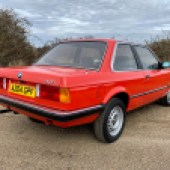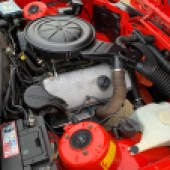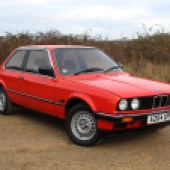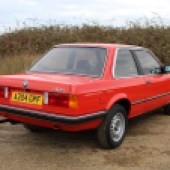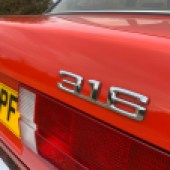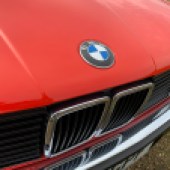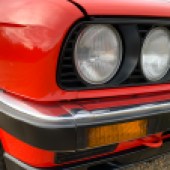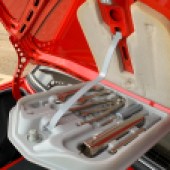One of the most iconic cars of the 1980s, the E30 3 Series remains a solid all-rounder in 2024. Here’s how to buy a great example
Words: Andrew Everett, Jon Burgess Images: Jeff Ruggles
The E30 3 Series arrived in 1982 as a replacement for the E21-generation car and remains one of BMW’s defining models. It says a lot about the era into which it was born: expensive and under-equipped compared to an equivalent Ford or Vauxhall, it had the cachet and depth of engineering that discerning buyers still crave today.
The E30 has graduated from the ‘banger’ phase it endured in recent years; not many are left as a result, and the good ones that remain can be expensive.
The time to buy an E30 was probably over a decade ago when good examples were a lot cheaper and parts were plentiful and cheap, but there’s still good reason to buy today. The E30 3 Series is now a price classic but a good one is a sure-fire investment; it’ll never go out of fashion.
The second-generation 3 Series arrived in March 1983 to replace the original E21 3 Series. Despite appearing to be a heavily revised version of the E21, nothing was carried over from the old car and the Claus Luthe styling was neat. The car arrived at the same time as the futuristic Ford Sierra but BMW’s gamble with restrained styling paid off.
The original models were the carburettor-fed 316 with a 90bhp 1766cc four-cylinder, the 320i with its LE Jetronic-injected 125bhp straight-six, and the 139bhp 2316cc 323i, which actually had 4bhp less than its K-Jetronic-injected predecessor but was bounced up to 150bhp by September with a few tweaks. At this point the E30 gained both a four-door option and a 105bhp 318i with an LE Jetronic-injected M10 four-cylinder.
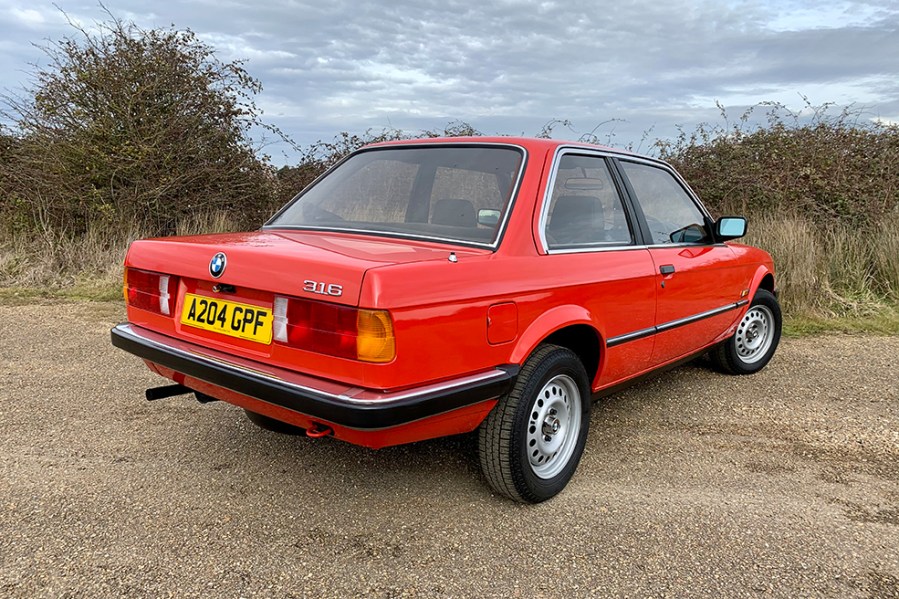
Spec was basic back then and everything was an option: radio, electric windows, sunroof, alloys, power steering, metallic paint, tinted glass, leather and Recaro style front seats, to name but a few.
The Baur Targa became available in 1984 on any two-door model and the full convertible arrived in the UK for 1986. By that time the 323i had given way to the 325i with Bosch Motronic engine management, making 171bhp from 2494cc.
A two-door 325i Sport arrived for late 1986 complete with Bilstein dampers, limited-slip diff, revised and lowered suspension, close-ratio gearbox (minus ‘dogleg’ change), plus 15-inch BBS alloy wheels, dechroming and limited colour choice of Lachs Silver, Dolphin Grey and Diamond Black. An M Technic sport steering wheel and sports seats with an M Technic bodykit as well as Houndstooth fabric trim and black headlining just about finished off this highly desirable car.
In late 1987, the E30 was given its facelift. Plastic bumpers, bigger tail lights, ellipsoid headlights and the lower cut rear arches from the Convertible were the obvious changes. Less obvious was the new 318i M40 engine, a new Motronic management system on the 320i and 325i and new trim and various other minor tucks and tweaks to combat new cars from other manufacturers.
A five-door Touring estate was also added as a 325i only at first but joined by the 320i in 1988 and 318i the following year, with a 316i version tagging on later. In late 1988, the 316 was replaced by the M40-engined 316i and BMW’s use of carburettors and the M10 engine passed into history. At the same time, BMW upgraded the E30’s basic spec with standard power steering, central locking, tinted glass and electric windows.
By this time, the all-new and very radical E36 was being readied for its 1991 launch. Even so, BMW released one of the E36’s four-valve-per-cylinder engines early and created the two-door 318iS. The four-cylinder car had M3 style tartan trim with sport seats, a choice of 14 or 15-inch BBS wheels (steels as standard), M Technic suspension, three-spoke M Technic steering wheel and a unique chin spoiler to go with the boot lip spoiler.
This lively and revvy number was a good seller; its was as fast as a 320i but with a character to make it of interest to maturing hot-hatch escapees. The 325i Sport had also made a welcome return in late 1988, with the same recipe as before but boasting a new bodykit and softer Boge Sachs dampers.
With that, E30 saloon production wound down in late 1990, replaced by the E36 in early 1991. The Convertible and Touring continued up to 1993 however, replaced in 1994 by their E36 successors.
Bodywork
The E30 was always a well-made car compared to its rivals, but most were savagely neglected. Such is the cost of new and used parts due to rarity that projects rarely make sense compared to just buying a good one.
Start at the front and check the condition of the lower front apron – a bolt-on panel – as it rusts at the outer extremities nearest the wheels. Front arches don’t often rust, but the lower front wings where they meet the sills definitely do. The front chassis legs and inner wings aren’t bad, but check the scuttle at the lower screen corners, under the fuse box and also where the inner wings meet the bulkhead.
Door bottoms are quite robust and any rust is normally cosmetic. Check the sills very carefully and make sure all four jacking point reinforcements are present, as well as the square front lifting pads where the sill meets the floor by the front wing.
Drop the glovebox down and see if you can spot any wetness or rust in the bulkhead area. Rear arch rust is a given on all but the best cars and facelift cars can really rot badly in the rear arch tubs – pull both rear boot side carpet trims out if possible.
The rear valance can rot – more so on facelift cars – but the bonnet and boot are good. Check the rear sills and the area around the rear axle beam mounts as this is expensive to put right. Check the corners of the boot seal lip by the rear lights as well. Touring tailgates can rust behind the lower screen seal.
The roof on sunroof cars needs careful inspection. The sunroof panel itself can rot merrily and a good used one is expensive now.
Rust in the roof skin is a bigger problem, however. Look all around the sunroof aperture and also look at the back of the roof skin and feel for any bumps, one each side. This is usually caused by rust between the sunroof cassette and the roof skin pushing through; the only repair is a new roof skin, or unbonding the cassette and welding in new metal – a very tricky job.
Chrome bumpers are very expensive used and rarely available new, while any parts for the 325i Sport’s plastic skirt panels are almost unobtainable new and pricey used if you can find them.

Engine and transmission
The E30 3 Series benefits from a range of great engines, providing they have been well maintained.
The M10 four-cylinder is considered unbreakable but camshaft wear was common due to neglect, infrequent oil changes and not checking the spray bar banjo bolts. BMW has made revised items with pre-applied dry threadlock and these, with slightly opened-up oil spray holes, helps the cam. A noisy timing chain at idle will mean a worn-out cam sprocket and an easy fix. The timing chains are very solid.
The M20 ‘small six’ is another good engine. The cambelt and tensioner needs replacing every 36,000 miles and a realistic job for a DIY mechanic; it makes sense to replace the water pump at the same time. Cam wear is common on neglected engines; budget at least £1500 for a garage to remove the head and replace it.
Broken 19mm head bolts (the head breaks off) could happen on pre-1989 units but it’s rare – it’s a cheap and easy DIY to fit a new set of Torx stretch bolts. Water in the oil and vice versa is never the head gasket, instead pointing to a crack in the head under the camshaft and into the coolant passage below. There are enough good used heads about for a DIY top-end rebuild – again, a realistic job for a competent DIY mechanic.
The M40 was a better engine than the M10 but again, neglect kills the camshaft – easy to replace, as is the cambelt should it be required. Running problems on any of these units will generally be a result of DIY tinkering and a failed sensor, cap or rotor arm.
Most E30s use a five-speed manual gearbox that’s cheap and easy to replace with a good used unit if required. The small diff on non-325i cars (plus late 323i models) can whine at higher mileages but it’s a simple replacement if needed. The bigger diff on other models, meanwhile, rarely gives trouble.
Automatic gearboxes are ZF units. These do not fare as as their manual counterparts at this age but used units are cheap enough. Worn propshaft front couplings and tired gear linkages are quite common but cheap to fix.

Suspension, steering and brakes
Front spring cups can rot out so they need to be inspected carefully and good used ones are now quite expensive on the 325i and Touring models with 51mm diameter struts. Rear subframe beam bushes wear out and are tricky to replace – a job best left to a specialist. On a test drive, feel for broken rear coil springs, tired dampers and bushes.
Power steering is much nicer than manual but E30 racks can leak and are seemingly tricky to successfully recondition as they often leak again. A conversion to the much better E36/E46 rack is quite expensive but is a fit-and-forget solution.
E30 brakes are pretty good but ABS faults can be a pain to fix and new parts are thinning out. A long brake pedal is usually just a sign that the cross linkage behind the dash needs adjustment. Rusty brake pipes and equally rusty callipers are best replaced.
Interior, trim and electrics
Rough trim in an E30 is expensive to fix but you can repair a tired driver’s seat with the covers from a good passenger seat or just fit the complete passenger seat if you don’t mind the adjuster on the wrong side as it actually works quite well.
Cracked dashboards are common and expensive to replace when a good used dash is £500 upwards. Little is available new and good used carpets, door trims and Touring headlinings are expensive because parts are now so rare.
The power hood on most Convertibles can be a real can of worms and faults can be a nightmare to put right, so many have been converted to manual operation.
The E30 is pretty simple compared to modern cars when it comes to electrics. The instrument cluster service indicator warning circuit board fails when the NiCad batteries leak their acid and good used ones are getting hard to find. The central locking module fails, mainly when overloaded by faulty locks and motors. Window and sunroof motors rarely go wrong and there are enough used ones to replace a dead unit.

BMW 3 Series (E30): our verdict
The E30 is a highly sought-after classic today, with prices to match. In an ideal world it’s the six-cylinder version that’s best: sadly, prices now reflect this and the 325i Sport is particularly out-of-reach for many. If you’re willing to compromise on power and performance, however, lowlier examples can still offer much of the same experience – and offer a great place to get started in the world of DIY classic-car ownership.
Condition is everything and major projects are rarely worthwhile, especially if rust is an issue. Restoration costs can spiral so it pays to buy the best example you can: it’s a far better idea to buy a really nice 320i than a rough 325i.
BMW 3 Series (E30) timeline
1976
Design work begins on the E30 project.
1982
All E30 types in production by October. Model announced officially as a two-door saloon in November with three models: 316, 320i and 323i.
1983
UK two-door sales begin in March, with four-door models arriving in November.
318i (M10) added to range; 320i and 323i get four-speed automatic option.
Karosserie Bauer offers the targa-style Top Cabriolet 2 (TC2) in lieu of an official convertible.
1984
US E30 sales begin.
1985
Mild interior and exterior facelift, including trim options and redesigned bumpers.
M20 2.3-litre straight-six (323i) replaced with M20 2.5-litre (325i) with 171bhp.
E30 Convertible previewed at the Frankfurt Motor Show. Motorsport homologation M3 also shown
Six-cylinder 324d (M21) diesel launched.
1986
Chrome deleted around doors and windows ahead of major facelift.
M3 goes on sale.
325i Convertible on sale in the UK.
325i Sport arrives for UK market.
Left-hand-drive 325iX on sale in UK with around 12 converted to right-hand-drive.
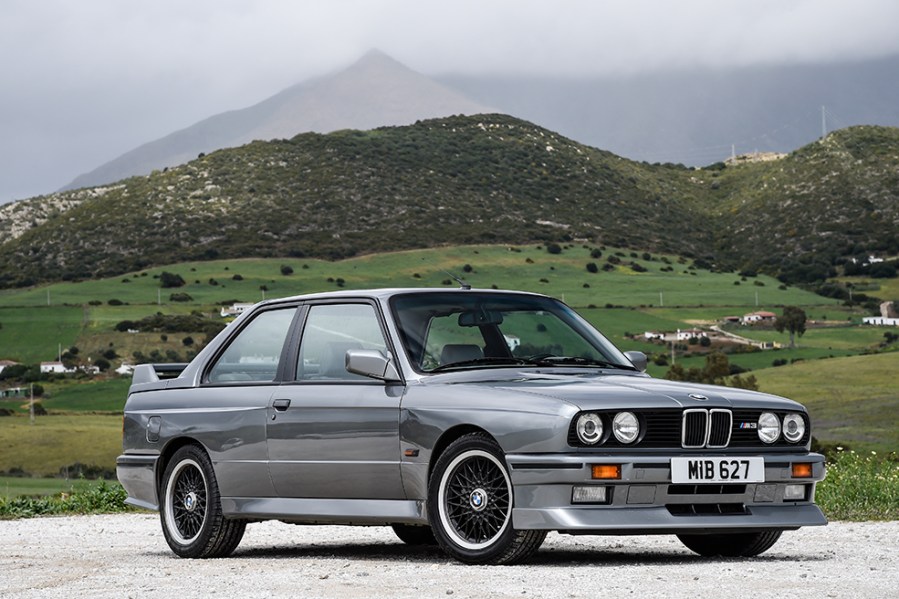
1987
Major facelift for the E30 includes plastic bumpers, bigger tail lights, reshaped rear arches and valance, new front apron and new headlights, plus some engine updates.
215bhp M3 Evolution I released.
1988
UK sales of the 3 Series Touring begin, available in 316, 318, 320 and 325 guise.
Carburetted 316 replaced with smaller-engined M40 316i variant.
Revised 325i Sport for UK market arrives.
220bhp Evolution II M3 released with 501 cars built.
Europa Meister ‘88 M3 special edition released, limited to148 units
M3 Convertible production starts.
1989
143bhp 16-valve 318is arrives as a VW Golf GTI 16v rival.
215bhp 2.3-litre engine becomes standard on the M3
235bhp 2.5-litre ‘Sport Evolution’ M3 unveiled in December.
Limited edition Roberto Ravaglia Edition and Johnny Cecotto Edition M3s produced
1990
E30 production begins to wind down in Germany as E36 begins to take over in September.
318iS arrives in right-hand drive.
316i/318i Lux models go on sale in UK in February.
‘Sport Evolution’ M3 production ends in March with 600 units produced; standard E30 M3 production ends in December.
1991
Two- and four-door saloon production ends in April, with Convertible and Touring models continuing until E36 equivalents arrive
1993
E30 Convertible production ends in April.
1994
Final E30 Touring leaves the line



